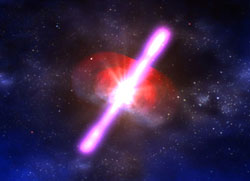
In 1912, Austrian physicist Victor Hess was using balloons to measure radiation levels in the Earth’s atmosphere. His innovative and meticulous work required him to travel with the balloon up to altitudes of 5.3 km, monitoring the measuring equipment and checking data.
The danger of traveling to such heights paid off for Hess. Unexpectedly, he found higher levels of radiation as the balloon rose and concluded that radiation was penetrating the atmosphere from outer space. The mysterious radiation was eventually called “cosmic rays”. One hundred years later, the nature of cosmic rays is well known; they are charged subatomic particles raining down from outer space. However, their origin is still a mystery. Two theories predominate: that cosmic rays come from massive black holes at the centers of active galaxies, or from the massive fireball thought to be produced during a gamma ray bursts (GRBs).
Using data from the IceCube Neutrino Observatory, astrophysicists Nathan Whitehorn and Pete Redl searched for neutrinos coming from the direction of known GRBs. And they found nothing.
Their result, appearing today in the journal Nature, challenges one of the two leading theories for the origin of the highest energy cosmic rays.
If gamma ray bursts are indeed the sources of cosmic rays, they must emit neutrinos. The model maintains that neutrinos are produced in the interactions of protons and photons coexisting in the GRB fireball.
Out of the sky and into the ice
IceCube is an array of over 5,000 sensors frozen into the ice under the South Pole.

ceCube is an array of over 5,000 sensors frozen into the ice under the South Pole.
Where Hess took his research to the skies, the IceCube collaboration headed in a different direction: deep into the ice.
The IceCube Neutrino Observatory is a high energy neutrino telescope built into the ice under the geographical South Pole. When a neutrino collides with a nucleus in the rock or ice inside or near the observatory, IceCube detects the faint blue light emitted by a secondary particle called a muon.
Neutrinos are of a ghostly nature. They can easily travel through people, walls or the entire planet Earth, rarely interacting with regular matter. IceCube is built on an enormous scale to compensate for the antisocial nature of neutrinos and catch their rare collisions. This ghostly nature allows neutrinos to travel the enormous distances from gamma ray bursts to the detector on the Earth.
One cubic kilometer of clear glacial ice, enough to fit the great pyramid of Giza 400 times, is instrumented with 5,160 optical sensors. IceCube was constructed using a hot-water drill. Eighty-six holes were drilled to 2.5 km deep and a string of sensors was deployed in each hole to complete the array. IceCube construction was finished in January 2011 by a collaboration of 250 physicists and engineers from the USA, Germany, Sweden, Belgium, Switzerland, Japan, New Zealand, Australia and Barbados.
The GRB neutrino search

GRBs are extremely powerful explosions, first observed by satellites using X-rays or gamma rays. GRBs are relatively frequent occurrences, seen about once per day around the visible Universe. Typical GRBs last a few seconds, and during this brief time they can outshine the rest of the Universe combined. Despite this, little is known about them.
Whitehorn and Redl studied 300 GRBs reported by satellites on the GRB Coordinates Network between May 2008 and April 2010, looking for any neutrinos originating from the observed gamma ray burst position and time.
At the time, IceCube was under construction. In the year from May 2008 to April 2009 it had 40 strings and in the second year of the study, IceCube operated 59 strings. Two independent data analysis methods were used and both resulted in no evidence for neutrinos being produced by GRBs.
Future directions
The lack of observation of neutrinos in coincidence with GRBs implies, at face value, that the theoretical models need to be revisited.
“Calculations embracing the concept that cosmic ray protons are the decay products of neutrons that escaped the magnetic confinement of the GRB fireball are supported by the research community and have been convincingly excluded by the present data,” says Francis Halzen, IceCube principle investigator and a professor of physics at the University of Wisconsin-Madison. “IceCube will continue to collect more data with a final, better calibrated and better understood detector in the coming years.”
Since April 2011, IceCube has collected neutrino data using the full detector array. With the larger detector, researchers can see more neutrinos, providing a “higher resolution” picture of the neutrino sky.
